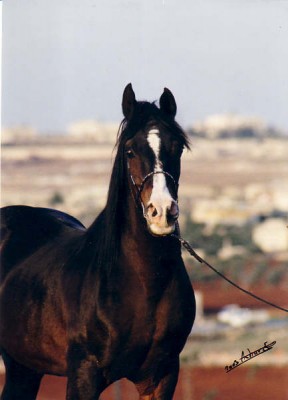Another picture of the desert-bred Kuhaylan al-Musinn stallion Ra’ad, from Syria
One more picture of Omar Anbarji’s now deceased desert-bred Kuhaylan al-Musinn stallion Ra’ad, this time by a professional photographer. I think this is the fourth picture of him I post.
I would like to familiarize readers with the foundation stock of the Syrian Arabians, because I feel they will become more and more significant in the future.
You have already seen pictures of some of the most influential Syrian Arabian stallions, many of which are personal favorites: Ra’ad, a Kuhaylan al-Musinn; al-Aa’war, a Hamdani Ibn Ghurab; Mubarak, another Hamdani Ibn Ghurab; Mokhtar, a Kuhaylan al-Krush; Marzuq, a Ma’naqi Sbayli, etc. Look them up in the search function of this blog on the right hand column, and you will see the relevant entry with their photos.
Ra’ad was bred by Jamal al-Turki al-‘Ilyu of the Saw’an clan, which is the leading clan of the settled, part peasant, part sheep-herding tribe of al-Sabkhah, on the banks of the middle Euphrates. Jamal’s family also bred Ra’ad dam Nawal al-Kheil, and her grand-dam as well. The Sabkhah, who occupy the area of same name (click here to see it on Google Map) are themselves part of the larger peasant confederation of the Bu Sha’ban.

While not Bedouins in the most restricted sense of the word (ie, camel herding Arab nomads), the sheep herding tribes of the fertile valley of the Euphrates and its tributaries became wealthier than their camel herding neighbours such the Fad’aan and the Sba’ah during the course of the twentieth century, because of the decline of the camel trading economy and the rise of mechanized agriculture and sheep herding. Their rise in wealth and power meant that, in time, they were able win the respect of their Bedouin neighbors who sometimes forged alliances with them by way of marriage. Exchange of horses were often the results of such alliances.
Although I currently have no direct information about this, I can garantee you that the Kuhaylan al-Musinn marbat of al-Saw’an comes from the well known (ma’ruf), famous (mashhur) and well ascertained (mazbut) marbat of Jadu’ Ibn ‘Amayer of the Fad’aan Bedouins. Ibn ‘Amayer’s was the premier marbat of the Kuhaylan al-Musinn in Syria, and it survived until the early 1980s.